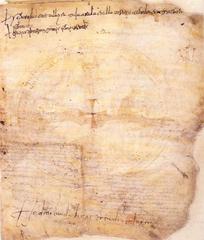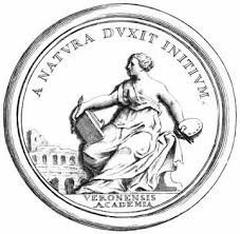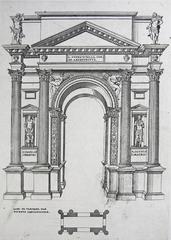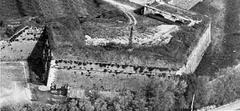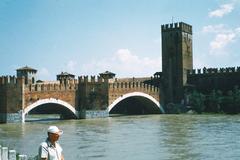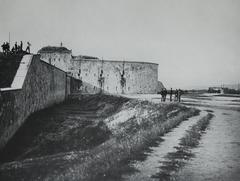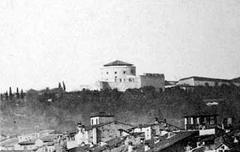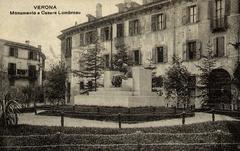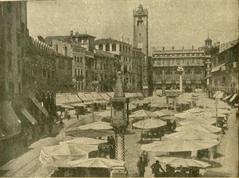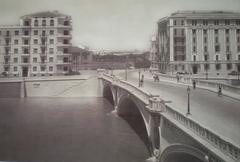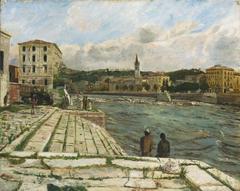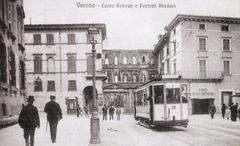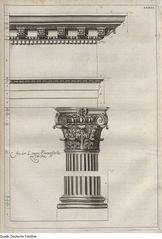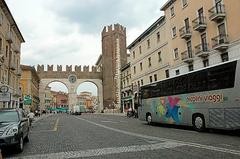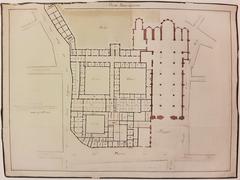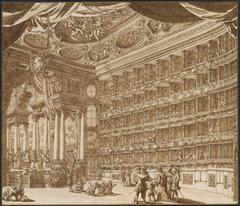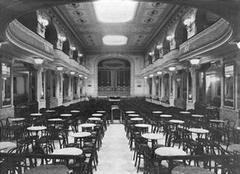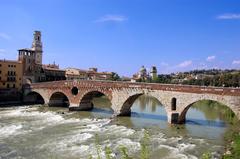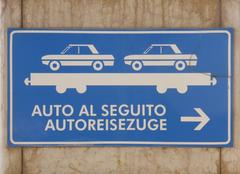
Biblioteca Capitolare di Verona: Visiting Hours, Tickets, and Historical Significance
Date: 14/06/2025
Introduction
The Biblioteca Capitolare di Verona stands as a living monument to over 1,500 years of European intellectual and cultural history. A cornerstone among Verona historical sites, it is recognized as the oldest library in continuous operation worldwide, dating back to approximately 517 A.D. Established as a scriptorium for the Chapter of Canons of Verona Cathedral, the library has safeguarded an unparalleled collection of manuscripts, incunabula, and archival documents through centuries of religious, political, and societal change. Today, it offers scholars and visitors alike a unique journey through the evolution of Western thought, illuminated by the artistry and innovation of medieval and Renaissance bookmaking (Zainoo; Avvenire).
Table of Contents
- Introduction
- Historical Overview
- Collections: Manuscripts, Incunabula, and Archives
- Visitor Information
- Visitor Experience
- Travel Tips and Nearby Attractions
- Frequently Asked Questions (FAQ)
- Conclusion
- References
Historical Overview
Origins and Early Development
Founded around 517 A.D., the Biblioteca Capitolare began as a scriptorium and writing workshop for the Chapter of Canons at Verona Cathedral (Zainoo). In an era marked by upheaval following the fall of the Western Roman Empire, the library provided a haven for sacred and classical texts, ensuring their preservation through turbulent centuries.
Medieval Flourishing and Manuscript Production
Through the Middle Ages, the Biblioteca Capitolare became a crucial center for scholarship and manuscript production. Expert scribes meticulously copied and illuminated texts spanning Christian theology, Latin classics, science, and law. Highlights from this era include the illuminated 5th-century “Gospel Purpureum,” early works of St. Augustine and Cicero, and the “Indovinello Veronese”—the earliest known text in the Italian vernacular (FAI; Verona Mostre).
Renaissance and Humanist Influence
During the Renaissance, the library attracted leading humanists eager to access original sources. Its holdings expanded to include works by Dante, Petrarch, and classical Roman legal texts such as the “Institutions” of Gaius. This period fostered vibrant intellectual exchange and contributed to the broader European Renaissance (Zainoo).
Modern Era: Preservation and Expansion
The modern era brought challenges from wars, natural disasters, and political changes, but the library endured. Today, its collection comprises around 75,000 items, including manuscripts, codices, parchments, incunabula, and musical scores. Ongoing restoration and digitization projects have further enhanced access and preservation (Biblioteca Capitolare di Verona – Official Site).
Cultural and Scholarly Significance
The Biblioteca Capitolare is distinguished by its:
- Historical Continuity: Offering a window into Europe’s religious and intellectual heritage.
- Manuscript Legacy: Housing some of the oldest and rarest Western manuscripts.
- Research Access: Supporting scholarly inquiry, with access to rare materials for qualified researchers.
- Public Engagement: Hosting guided tours, exhibitions, and educational workshops (Biblioteca Capitolare di Verona – Official Site).
Collections: Manuscripts, Incunabula, and Archives
Manuscripts
The collection features over 1,200 unique codices covering theology, philosophy, law, literature, natural science, and music. Treasures include:
- “Gospel Purpureum”: 5th-century illuminated gospel.
- “Indovinello Veronese”: Earliest known text in Italian vernacular.
- “Institutions” of Gaius: A rare, unaltered Roman law manuscript (FAI).
- Sacramentary of St. Wolfgang: Exceptional 10th-century liturgical manuscript (Avvenire).
Incunabula and Early Printed Books
The library also preserves:
- 245 incunabula (pre-1501 printed books)
- 2,500 16th-century (cinquecentine) and 2,800 17th-century (seicentine) editions
- Over 70,000 volumes from the 18th century onward (Visit Verona).
Archival Holdings
The archival collection includes:
- Approx. 11,000 parchments, the oldest from 710 CE
- Hundreds of paper document folders from the 13th century onward (Biblioteca Capitolare).
Artistic and Musical Heritage
Beyond manuscripts, the library houses:
- Paintings and sacred art
- Ancient musical instruments
- Tools related to printing and bookbinding (Veronissima).
Digitalization and Conservation
Ongoing restoration and digitization projects allow global scholarly access while preserving the delicate originals (Veronissima).
Visitor Information
Location and Access
- Address: Piazza Duomo 13 and 19, adjacent to the Verona Cathedral (Chiese Verona).
- The library is centrally located, making it easy to combine with visits to other Verona historical sites.
Visiting Hours
- Museum Route: Thursday to Tuesday, 10:00 a.m. – 5:30 p.m. (last admission at 5:00 p.m.; closed Wednesdays)
- Consultation Room: Monday to Friday, 9:00 a.m. – 12:30 p.m.
- Seasonal Variations: Hours may change in winter; always check the official website before your visit (Chiese Verona).
Tickets and Booking
- Museum Admission: €7 (full), €6 (concessions: ages 11–14, VeronaCard holders, partners), free for children under 10, ICOM members, visitors with disabilities and caregivers, and licensed guides.
- Guided Tours: €15 (full), €10 (concessions). Tours last 1h45–2h, available in Italian and English by reservation (Verona Mostre).
- Workshops and Events: Prices vary; advance booking recommended.
- Verona Card Holders: Free library admission with the card (Chiese Verona).
- Combined Tickets: Available for the Cathedral Complex and other churches.
- Booking: Recommended for guided tours, special events, and groups (20+). Reserve via email ([email protected]) or call +39 331 594 6961.
Accessibility
The library is partially accessible. Some areas may present challenges for visitors with limited mobility; contact staff before visiting to discuss specific needs and possible arrangements (Chiese Verona).
COVID-19 and Seasonal Considerations
Check the official website for current health protocols and any seasonal adjustments to hours or access.
Visitor Experience
Guided Tours and Workshops
- Guided Tours: Explore the Canonical Cloister, monumental hall, and original manuscript exhibitions. Thematic tours and special events—such as “Meeting the Amanuensis”—offer hands-on experiences in historic manuscript creation (Verona Mostre).
- Educational Programs: Tailored for school groups and families.
Special Events and Photographic Spots
- The library regularly hosts exhibitions and events that highlight its collections and research.
- Photography: Restricted to specific areas; always ask staff before photographing.
Architectural Highlights
- Canonical Cloister: A tranquil space reflecting the library’s ecclesiastical roots.
- Main Reading Room: 18th-century design, restored after WWII, featuring historic woodworking and furnishings.
Travel Tips and Nearby Attractions
- Best Times to Visit: Weekdays and mornings tend to be less crowded.
- Combine Visits: The library is steps from the Verona Cathedral, Church of Sant’Elena, and Museo Canonicale. The Arena, Juliet’s House, and Piazza delle Erbe are within walking distance.
- Transportation: The library is centrally located; use public transport or city-center parking.
- Verona Card: Consider purchasing for access to multiple sites and public transport.
Frequently Asked Questions (FAQ)
Q: What are the Biblioteca Capitolare di Verona visiting hours?
A: The museum is open Thursday–Tuesday, 10:00 a.m.–5:30 p.m. (last admission 5:00 p.m.), closed Wednesdays. Research room: Mon–Fri, 9:00 a.m.–12:30 p.m.
Q: How do I book a guided tour or event?
A: Reserve by emailing [email protected] or calling +39 331 594 6961. Book at least 7 days in advance for groups or special events.
Q: Is the Biblioteca Capitolare accessible for visitors with disabilities?
A: The itinerary is partially accessible; contact staff before visiting to discuss your needs.
Q: Are children allowed?
A: Yes, children under 10 enter free. Workshops and educational materials are available for younger visitors.
Q: Can I use the Verona Card for free admission?
A: Yes, the Verona Card includes free access to the library.
Q: Is photography permitted?
A: Photography is restricted. Some areas allow photos without flash; always check with staff.
Conclusion
The Biblioteca Capitolare di Verona is a remarkable testament to cultural resilience and the enduring pursuit of knowledge, offering an immersive experience that connects visitors to the roots of European civilization. From its priceless collections to its evocative architecture and dynamic public programming, the library is a must-visit for anyone exploring Verona historical sites. For the best experience, check visiting hours, book tours in advance, consider using the Verona Card, and explore nearby landmarks to make the most of your visit. Enhance your journey with digital resources and stay updated on events with the Audiala app.
References
- This article references the following sources for further information and official details:
